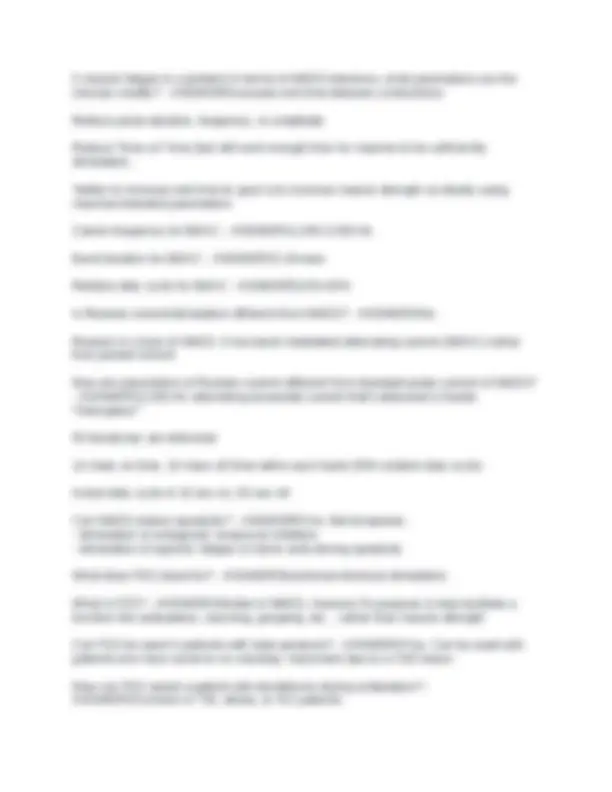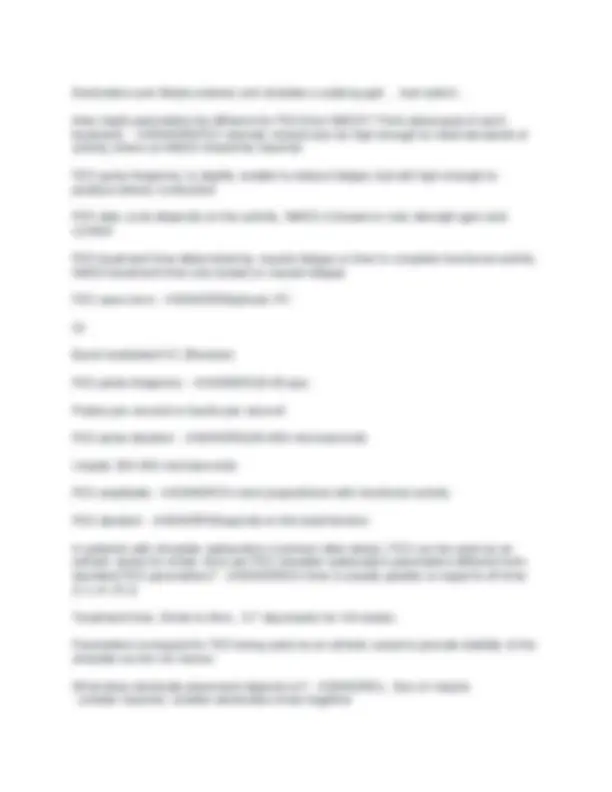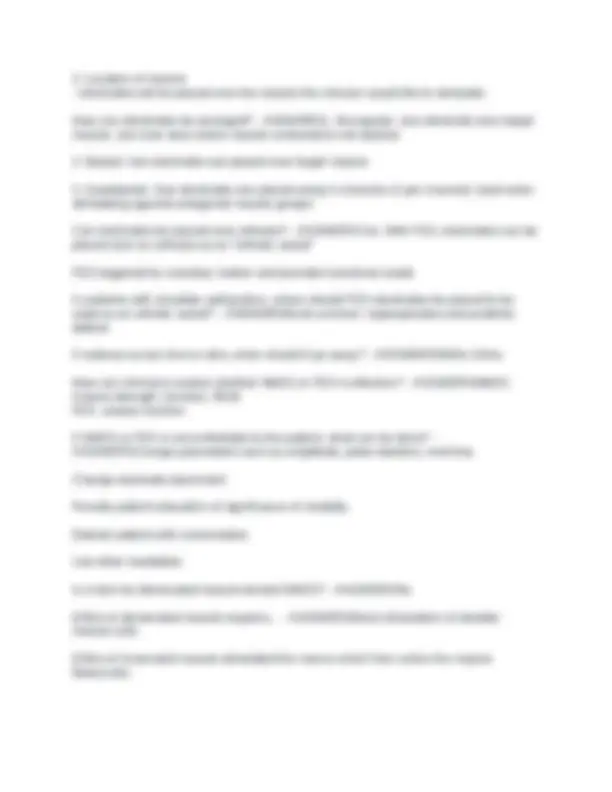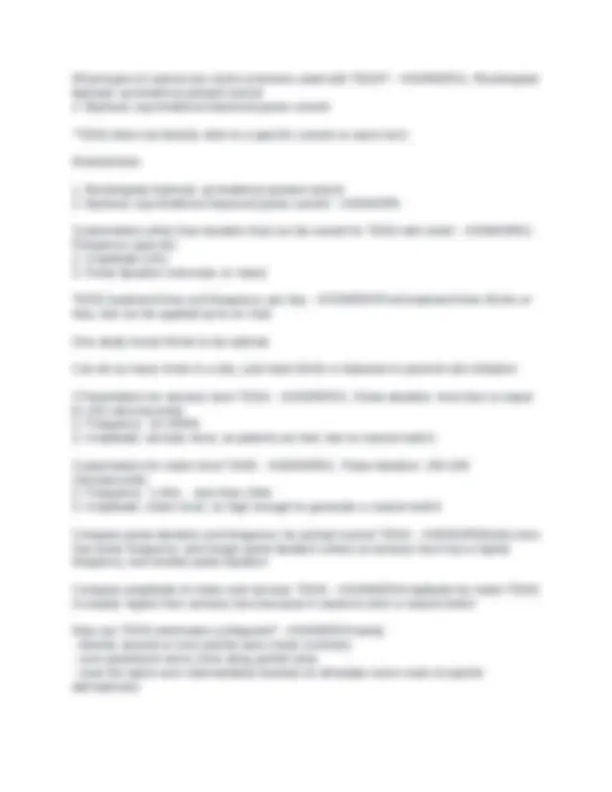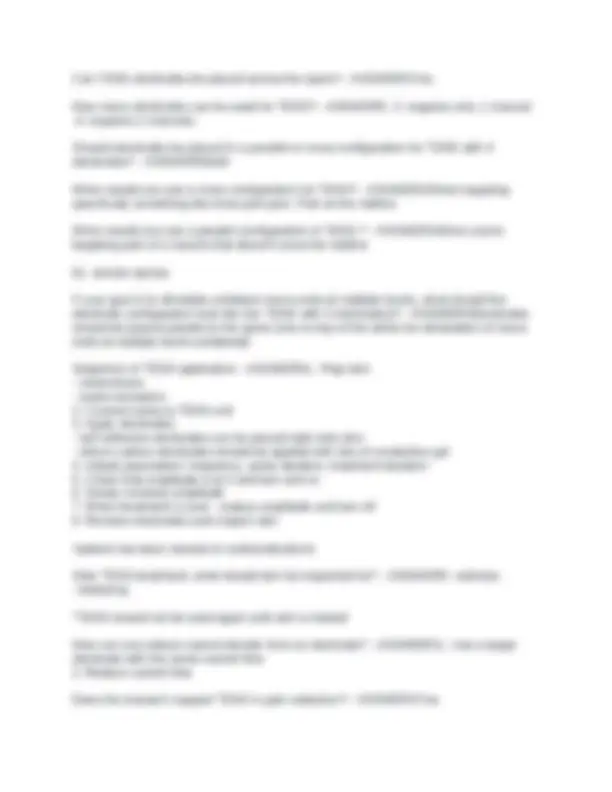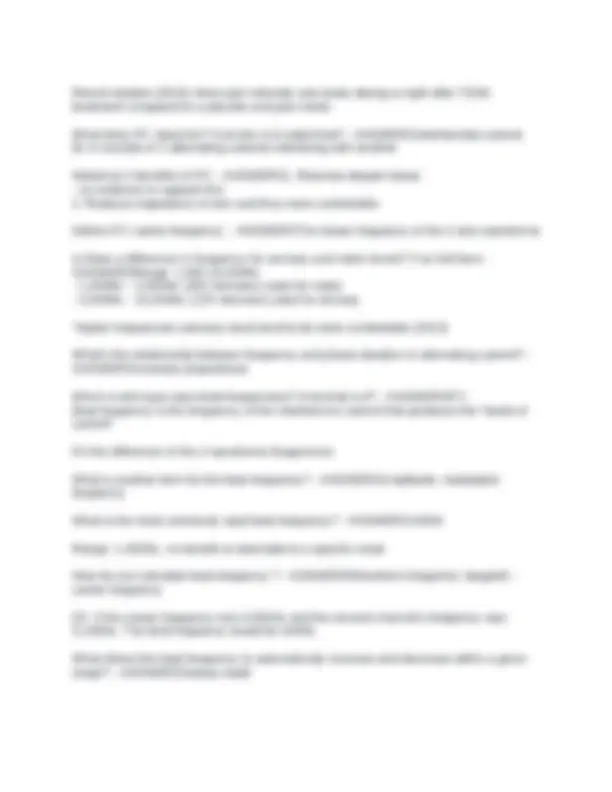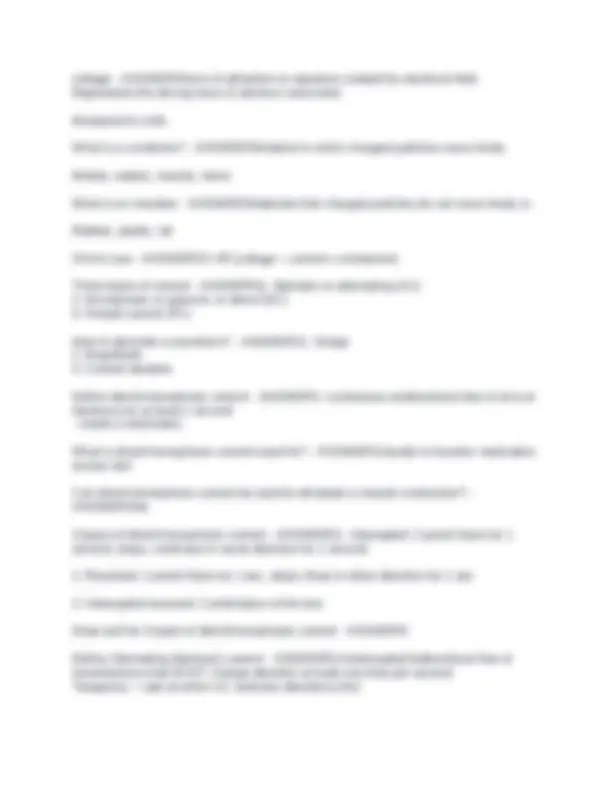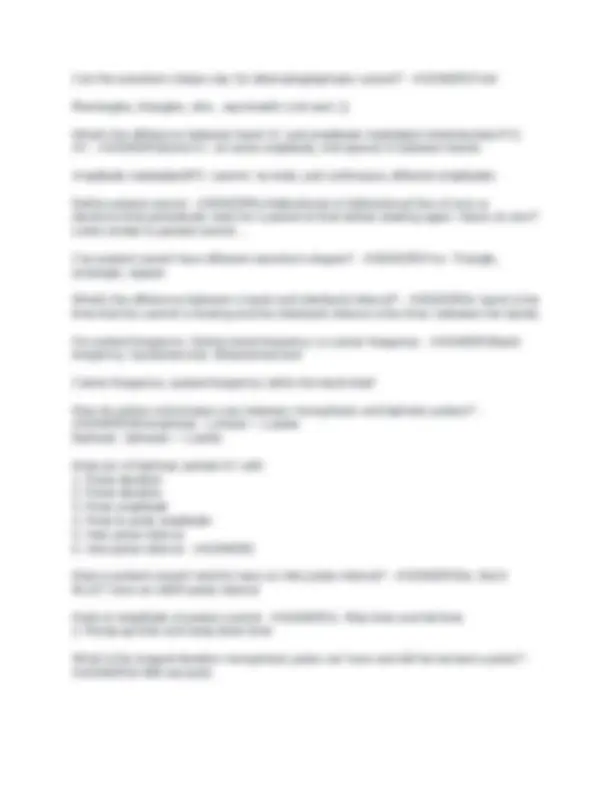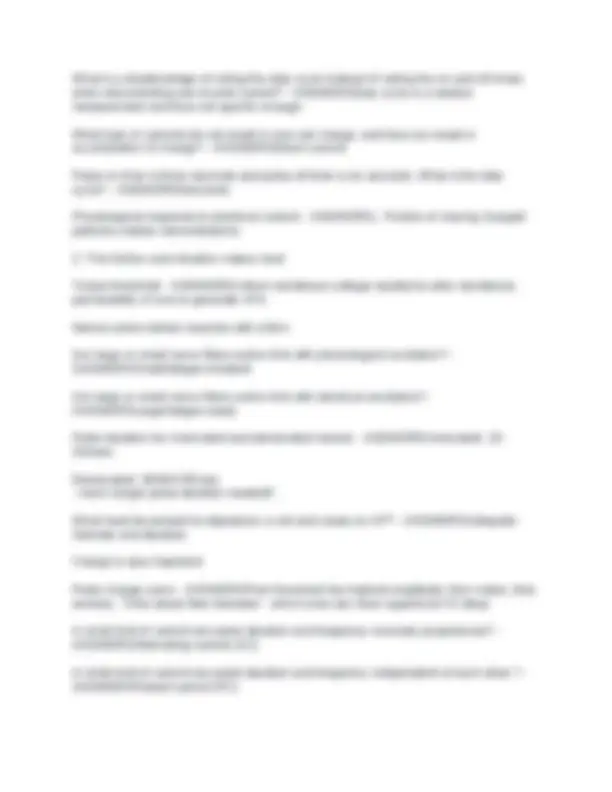Download Electrical Stimulation: NMES, FES, and Denervated Muscle Stimulation - Q&A and more Exams Nursing in PDF only on Docsity!
Electrical stim Questions & Answers
What does NMES stand for? - ANSWERSneuromuscular electrical stimulation NMES general goal - ANSWERSIntroduce contraction of skeletal muscle to obtain similar physiological improvements that result from exercise training Is NMES supported by research? - ANSWERSYes. It's been shown to improve:
- muscle strength
- muscle mass
- strength after TKA & ACL reconstruction
- strength/ function in people with critical illness Examination techniques before NMES? - ANSWERS- strength: determine effect of NMES treatment
- sensation: if absent or diminished, more frequent monitoring required
- function: determine effect of NMES on function
- cognition: ensure safety of NMES use Why should the innervation status of the muscle be noted with use of NMES? - ANSWERS- denervated muscle won't respond to NMES
- if innervation status unknown , can use NMES to determine What waveforms are used with NMES? - ANSWERSBMAC: burst-modulated alternating current (Russian current) Symmetrical or asymmetrical biphasic pulsed current Draw BMAC and symmetrical currents - ANSWERS Pulse duration for NMES - ANSWERS200-600 microseconds Or up to 800
Why is pulse duration higher for NMES than for e-stim for pain management? - ANSWERSBc more charge is required to stimulate motor nerves AND charge depends on pulse duration (and amplitude) What frequencies are used with NMES - ANSWERS20-100 pps (Hz) Pulses per second Frequency should be increased until smooth tetanic contraction is obtained
- usually >30pps What amplitude is used with NMES? - ANSWERSHigh enough to obtain a strong muscle contraction ≥50% of maximal voluntary contraction (MVC) Many studies use near 70% MVC Are ramp up or ramp down times used with pulsed current NMES? - ANSWERSBoth are recommended for patient comfort.
- typical ramp up: 1-5sec -typical ramp down: 1-2sec Why might ramp-up time need to be longer than ramp-down time? - ANSWERS- can give the patient time to adjust to stimulus, more comfortable
- ramp down time is less important than ramp up time
- fast ramp down time can be uncomfortable Is a longer ramp-up time always indicated? - ANSWERSNo Longer ramp up time means motor units are activated for less time (over all time is the same) Muscles should be activated for "sufficient" periods of time. Ramp up time should not be greater than 5 sec Duty cycle ratios for NMES? - ANSWERS1:3 or 1: So time on 10sec to time off 30sec or 50sec NMES treatment duration? - ANSWERS10 contractions OR 1hr/day 3-5x per week for 4-8 weeks T/F: the general goal of NMES is to improve muscle strength so the highest pulse duration and amplitude tolerable should be used - ANSWERSTrue. Most studies show muscle strength improvement when "maximal tolerated" intensities were used.
Electrodes over tibialis anterior and simulate a walking gait ... foot switch... How might parameters be different for FES than NMES? Think about goal of each treatment. - ANSWERSFES intensity should only be high enough to meet demands of activity where as NMES should be maximal FES pulse frequency is slightly smaller to reduce fatigue, but still high enough to produce tetanic contraction FES duty cycle depends on the activity, NMES is based on max strength gain and comfort FES treatment time determined by muscle fatigue or time to complete functional activity. NMES treatment time only based on muscle fatigue FES wave form - ANSWERSBiphasic PC Or Burst modulated AC (Russian) FES pulse frequency - ANSWERS20-60 pps Pulses per second or bursts per second FES pulse duration - ANSWERS200-800 microseconds Usually 200-400 microseconds FES amplitude - ANSWERSTo level proportional with functional activity FES duration - ANSWERSDepends on the task/function In patients with shoulder subluxation (common after stoke), FES can be used as an orthotic assist for rehab. How are FES shoulder subluxation parameters different from standard FES parameters? - ANSWERSOn time is usually greater or equal to off time (1:1 or 15:1) Treatment time: 20min to 6hrs , 5-7 days/week for 4-8 weeks Parameters increased bc FES being used as an orthotic assist to provide stability of the shoulder as the UE moves What does electrode placement depend on? - ANSWERS1. Size of muscle
- smaller muscles: smaller electrodes closer together
- Location of muscle
- electrodes will be placed over the muscle the clinician would like to stimulate How can electrodes be arranged? - ANSWERS1. Monopolar: one electrode over target muscle, one over area where muscle contractions not desired
- Bipolar: two electrodes are placed over target muscle
- Quadripolar: four electrodes are placed using 2 channels (2 per channel) Used when stimulating agonist-antagonist muscle groups Can electrodes be placed over orthosis? - ANSWERSYes. With FES, electrodes can be placed over an orthosis as an "orthotic assist" FES triggered by voluntary motion and provides functional assist In patients with shoulder subluxation, where should FES electrodes be placed to be used as an orthotic assist? - ANSWERSMost common: supraspinatus and posterior deltoid If redness occurs from e-stim, when should it go away? - ANSWERSWithin 24hrs How can clinicians assess whether NMES or FES is effective? - ANSWERSNMES: Assess strength, function, ROM FES: assess function If NMES or FES is uncomfortable to the patient, what can be done? - ANSWERSChange parameters such as amplitude, pulse duration, rest time. Change electrode placement Provide patient education of significance of modality. Distract patient with conversation Use other modalities Is e-stim for denervated muscle termed NMES? - ANSWERSNo EStim of denervated muscle requires... - ANSWERSDirect stimulation of skeletal muscle cells EStim of innervated muscle stimulated the nerves which then active the muscle fibers/cells
Clinically, does eStim for denervated muscle show any benefit? - ANSWERSNo, more research is needed. Some research says it's beneficial, some research says it's harmful. Key point: eStim of denervated muscle is not widely endorsed or practiced, however it's still done despite questionable efficacy and you should "proceed with caution" What are the optimal parameters for eStim of denervated muscle - ANSWERSTBD Can you use NMES if muscle is partially denervated? - ANSWERSYes. You can still access in innervated motor units. What are the proposed theoretical bases for electroanalglesia? - ANSWERS- Gate theory
- release of opioids and activation of opioid receptors What does TENS stand for? - ANSWERStranscutaneous electrical nerve stimulation TENS implies the use of electrical stimulation for what purpose? - ANSWERSAttenuating or alleviating pain What are the 4 modes/types of TENS and which are the 2 main types? - ANSWERS1. Conventional/high frequency/sensory
- Acupuncture/low frequency/motor
- Burst Train
- Brief Intense *1 and 2 are the main types If person has an opioid tolerance, what frequency is needed to optimize analgesic effect? - ANSWERS>50pps High-frequency TENS may be more effective for those taking opioids Is TENS a specific type of equipment or electrical current? - ANSWERSNo: use of TENS is a method of activating nerve fibers by delivering electrical impulses through the skin using surface electrodes. It is not a specific type of equipment or electric current. T/F: the term "TENS" is designed to describe the use of a handheld stimulator for pain control. - ANSWERSFalse The term TENS has often been inaccurately used to describe that. However, many large units and line powered stimulated offer the same parameters and are well-suited for TENS (just not portable)
What types of current are most commonly used with TENS? - ANSWERS1. Rectangular biphasic symmetrical pulsed current
- Biphasic asymmetrical balanced pulse current *TENS does not directly refer to a specific current or wave form Draw/picture
- Rectangular biphasic symmetrical pulsed current
- Biphasic asymmetrical balanced pulse current - ANSWERS 3 parameters other than duration that can be varied for TENS with units! - ANSWERS1. Frequency (pps,Hz)
- Amplitude (mA)
- Pulse duration (microsec or msec) TENS treatment time and frequency per day - ANSWERSFirst treatment time 30min or less, but can be applied up to an hour One study found 40min to be optimal Can do as many times in a day, just need 30min in between to prevent skin irritation 3 Parameters for sensory level TENS - ANSWERS1. Pulse duration: less than or equal to 100 microseconds
- Frequency: 10-250Hz
- Amplitude: sensory level, so patient can feel, but no muscle twitch 3 parameters for motor level TENS - ANSWERS1. Pulse duration: 150- microseconds
- Frequency: 1-4Hz... less than 10Hz
- Amplitude: motor level, so high enough to generate a muscle twitch Compare pulse duration and frequency for pulsed current TENS - ANSWERSMotor tens has lower frequency and longer pulse duration where as sensory tens has a higher frequency and shorter pulse duration Compare amplitude of motor and sensory TENS - ANSWERSAmplitude for motor TENS is usually higher than sensory tens because it needs to elicit a muscle twitch How are TENS electrodes configured? - ANSWERSVariety
- directly around or over painful area (most common)
- over peripheral nerve inner sting painful area
- near the spine over intervertebral foramen to stimulate nerve roots of painful dermatomes
Recent studies (2022) show pain intensity was lower during or right after TENS treatment compared to a placebo and pain meds What does IFC stand for? And why is it called that? - ANSWERSinterferential current. Bc it consists of 2 alternating currents interfering with another. Historical 2 benefits of IFC - ANSWERS1. Reaches deeper tissue
- no evidence to support this
- Reduces impedance of skin and thus more comfortable Define IFC carrier frequency. - ANSWERSThe lesser frequency of the 2 sine waveforms Is there a difference in frequency for sensory and motor levels? If so list them. - ANSWERSRange: 1,000-10,000Hz
- 1,000Hz - 2,000Hz (250 microsec) used for motor
- 4,000Hz - 10,000Hz (125 microsec) used for sensory *higher frequencies (sensory level) tend to be more comfortable (2013) What's the relationship between frequency and phase duration in alternating current? - ANSWERSInversely proportional Which e-stim type uses beat frequencies? And what is it? - ANSWERSIFC Beat frequency is the frequency of the interference current that produces the "beats of current" It's the difference of the 2 waveforms frequencies What is another term for the beat frequency? - ANSWERSAmplitude- modulated frequency What is the most commonly used beat frequency? - ANSWERS100Hz Range: 1-200Hz, no benefit or downside to a specific value How do you calculate beat frequency? - ANSWERSWaveform frequency (larger#) - carrier frequency EX: if the carrier frequency was 4,000Hz and the second channel's frequency was 4,100Hz. The best frequency would be 100Hz. What allows the beat frequency to automatically increase and decrease within a given range? - ANSWERSSweep mode
What's the purpose of sweep mode? - ANSWERSTo prevent or reduce sensory inhibition However, lack of evidence that sweep mode is significant What is Vector Scan? And what are the options? - ANSWERSVector scan is an amplitude modulation resulting in expansion of the the clover leaf field area. The larger in % increase, the larger the area increase between the 4 electrodes. Options:
- static
- 10,40,100% What kind of waveform/frequency is IFC? - ANSWERSBiphasic balanced alternating AKA: amplitude modulated frequency Will IFC have charge accumulation at one electrode? - ANSWERSNo, bc the waveform is balanced. There is zero net charge *can be used for long periods bc it won't impact chemical burns on the skin Varried parameters for IFC - ANSWERS1. Carrier Frequency
- Amplitude
- Beat frequency
- Sweep mode IFC treatment duration and frequency per week - ANSWERSTreatment duration: 10- 30min
- controversial Treatment frequency: ~2x/week for 2-4weeks Can IFC electrodes cross the spine? - ANSWERSYes How many electrodes and channels does IFC use? - ANSWERS2 channels 4 electrodes Configuration of IFC electrodes - ANSWERSMust cross. Most commonly places directly around for over painful area Differences between IFC and TENS application steps - ANSWERS1. Electrodes for IFC musky be crossed and this have 4 electrodes What parameters does the clinician select that IFC and TENS have in common? - ANSWERSAmplitude and duration of treatment
voltage - ANSWERSforce of attraction or repulsion created by electrical field. Represents the driving force of electron movement Measured in volts What is a conductor? - ANSWERSMaterial in which charged particles move freely. Metals, waters, muscle, nerve What is an insulator - ANSWERSMaterials that charged particles do not move freely in. Rubber, plastic, fat Ohm's Law - ANSWERSV=IR (voltage = current x resistance) Three types of current - ANSWERS1. Biphasic or alternating (AC)
- Monophasic or galvanic or direct (DC)
- Pulsed current (PC) How to describe a waveform? - ANSWERS1. Shape
- Magnitude
- Current duration Define direct/monophasic current - ANSWERS- continuous unidirectional flow of ions or electrons for at least 1 second
- needs 2 electrodes What is direct/monophasic current used for? - ANSWERSUsually to transfer medication across skin Can direct/monophasic current be used to stimulate a muscle contraction? - ANSWERSNo. 3 types of direct/monophasic current - ANSWERS1. Interrupted. Current flows for 1 second, stops, continues in same direction for 1 second
- Reversed. Current flows for 1 sec, stops, flows in other direction for 1 sec
- Interrupted reversed. Combination of the two Draw out the 3 types of direct/monophasic current - ANSWERS Define Alternating (biphasic) current - ANSWERSUninterrupted bidirectional flow of ions/electrons that MUST change direction at least one time per second *frequency = rate at which AC switches directions (Hz)
Can the waveform shape vary for alternating/biphasic current? - ANSWERSYes! Rectangles, triangles, sine , asymmetric (cat ears :)). What's the difference between burst AC and amplitude modulated (interferential IFC) AC - ANSWERSBurst AC: all same amplitude, rest spaces in between bursts Amplitude modulated/IFC current: no rests, just continuous, different amplitudes Define pulsed current - ANSWERSUnidirectional or bidirectional flow of ions or electrons that periodically rests for a period of time before starting again. Never at zero? Looks similar to pulsed current.... Can pulsed current have different waveform shapes? - ANSWERSYes. Triangle, rectangle, square What's the difference between a burst and interburst interval? - ANSWERSA burst is the time that the current is flowing and the interburst interval is the time i between the bursts For pulsed frequency: Define burst frequency vs carrier frequency - ANSWERSBurst frequency: bursts/second, 50bursts/second Carrier frequency: pulsed frequency within the burst itself How do pulses and phases vary between monophasic and biphasic pulses? - ANSWERSMonophasic: 1 phase = 1 pulse Biphasic: 2phases = 1 pulse Draw pic of biphasic pulsed AC with:
- Pulse duration
- Pulse duration
- Peak amplitude
- Peak to peak amplitude
- Inter pulse interval
- Intra pulse interval - ANSWERS Does a pulsed current need to have an intra pulse interval? - ANSWERSNo. But it MUST have an intER pulse interval Parts of amplitude of pulses current - ANSWERS1. Rise time and fall time
- Ramp up time and ramp down time What is the longest duration monophasic pulse can have and still be termed a pulse? - ANSWERS0.999 seconds
Critical fusion frequency - ANSWERSWhen a muscle cell is depolarized enough to form a tetanic contraction
- 25-75pps
- most functional Higher frequency —> stronger contraction What kinds of electrodes are present in pulsed monophasic or direct current (DC)? - ANSWERSOne cathode and one anode What kinds of electrodes are present in balanced pulsed current (PC) waveform generators? - ANSWERSBoth electrode leads will alternate as cathode and anode. So the net charge is 0 and color of lead wires doesn't mean anything Qualities of good electrodes - ANSWERSGood and uniform conduction Durable Hypoallergenic Easy application and removal Disposable or cleanable Should you clean electrodes with alcohol based cleansers? - ANSWERSNo. It could increase resistance. Use soap and water instead How to place electrodes if targeting superficial vs deep tissue? - ANSWERSSuperficial tissue: closer together Deep tissue: farther apart Where is a motor nerve most excitable? - ANSWERSMuscle belly or proximal 1/3 of muscle Where is a sensory nerve most excitable? - ANSWERSDirectly over sensory nerve Does a larger electrode have a higher current density than a small electrode with the same current? - ANSWERSNo. But this might make it more comfortable! Can you use eStim over the trunk or chest in a patient with a pacemaker or ICD? - ANSWERSNo. Contraindication. Can you use eStim on the anterolateral neck? - ANSWERSNo. Carotid bodies. Can you use eStim with a patient who has DVT/thrombosis/peripheral vascular disease? - ANSWERSNo. Can you use eStim with a patient who lacks intact sensation? - ANSWERSYes. Precaution
Can you use eStim with a patient who has epilepsy? - ANSWERSYes. Precaution Can you use eStim with a patient who susceptible to hematoma or hemorrhage? - ANSWERSYes. Precaution Can you use eStim with a patient who has cardiac dysfunction? - ANSWERSYes. Precaution Can you use eStim near diathermy? - ANSWERSNo.

